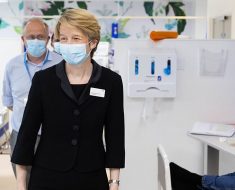For more than a century, Centura Health, based in Centennial, Colorado, has strived to define whole person care. The organization says it improves lives and strengthens communities by honoring the mind, body and spirit in equal measure.
Further, it says it understands the way care is provided is as meaningful as the care itself, which is why it listens to and connects with every patient it serves.
THE PROBLEM
Centura Health had been experiencing issues with its virtual care tool set before COVID-19 first hit in the U.S. Much like the rest of the healthcare industry, at the start of the pandemic, the patient load was overwhelming.
“Virtual care required a recast in strategy to address interoperability, patient experience, provider experience and cost,” said Gerard Frunzi, director of virtual care at Centura Health. “Interoperability issues resulted in many manual steps to get information between systems and tasks completed.
“User experience deficiencies highlighted the importance of easy-to-use telemedicine tools as it directly impacted the effectiveness of clinical services,” he continued. “Then and now, the provider decides whether to accept telehealth as a service in their practice based on the clinician experience. Traditional end-to-end vendors in virtual care were and still are pricey on annual operating budgets.”
Centura Health’s Epic electronic health record offered most features available for telemedicine services, so it eventually transitioned to Epic Video Client for virtual care.
Centura Health was awarded just over $997,000 in grant funds from the FCC for telemedicine. The funds are being used for two projects. Centura will complete the transition by year’s end. Telemedicine carts will transition to Iron Bow, leveraging Cisco’s back-end and remote patient systems. Monitoring will transition to Health Recovery Solutions.
PROPOSAL
Aligning new technology and features with the Epic EHR has created more effective telehealth care pathways, Frunzi explained.
“Services transitioned and, in some cases, supplemented clinical process and workflow,” he said. “Implementing additional Epic telemedicine features decreased errors. Some added features allowed for process flexibility when the technology broke.
“For example, a patient having trouble launching the video product on a computer could then be texted a direct link to a smartphone for a successful telemedicine visit,” he added.
Expanding the telehealth cart fleet and replacing aging technology will satisfy a significant need in Centura Health’s system, he said. COVID-19 surges highlighted this lack of technology. Discharge support including deferring care to the home was another strategic need for care in general and for COVID-19 surge management, he added.
MARKETPLACE
There are many vendors of telemedicine technology and services on the health IT market today. Healthcare IT News published a special report highlighting many of these vendors with detailed descriptions of their products. Click here to read the special report.
MEETING THE CHALLENGE
Applying for FCC funds and executing on the vendor selection process was work done by Frunzi’s four-person team, clinical leadership, IT, and vendors for build and configuration, and legal and regulatory staff.
“An organization’s digital strategy is often tied to the capability of its EHR, and when that system is feature-rich, it continually evolves,” Frunzi noted. “Epic regularly expands telemedicine features and functionality. This is especially true in system integration for outpatient video.
“Features around orders, notes and alerts also have expanded to support tele-enabled ED, inpatient and remote patient monitoring workflows,” he continued. “The telehealth carts operate separately from Epic currently, leveraging the same video product as our integrated phone system.”
Centura Health managed devices already have the correct tools to directly engage in the video cart and room systems, reducing time for coordinating consults in inpatient and ED settings, he added.
Centura Health is extending its ministry with a new hospital, St. Francis InterQuest in Colorado Springs, which is designed as a hospital of the future. This project is separate from the FCC-funded work.
“The new hospital’s rich integration of GetWell Network entertainment with Epic and Cisco ExtendedCare will create cutting-edge interoperability,” Frunzi said. “Each inpatient and ED room will have its own dedicated video unit on top of the entertainment TV.
“Providers and caregivers will engage the video workflow directly through Epic, removing any need for local moving around of carts,” he added. “The solution additionally includes clinical interpretation, family-centered rounding and automated discharge support. System innovation at St. Francis InterQuest expands far beyond the virtual care offerings.”
RESULTS
Centura Health has not yet deployed the new telehealth carts nor fully replaced the remote patient monitoring technology, so it has yet to record success metrics. Patient experience survey scores have been the baseline success metric for outpatient care.
“New features and service offerings for at-home video conferencing have resolved most problems that used to occur,” Frunzi reported. “We continue to refine these with interventions like a self-help link in text message reminders to support patient self-service. Highlighting automated technology testing to make sure the video tool sees a camera, microphone and speaker.
“Implementation of a new Epic track board feature helped provide advance warning to the clinic when a patient is late checking in or not on video yet in advance of their video visit,” he continued. “That track board feature also tells the clinic when things are going well, and the patient is waiting in the room. This allows clinics to focus the limited team member energy where it’s needed and know when it’s not needed.”
During the height of COVID-19, most organizations peaked around March and May of 2020, then reduced to what is a new average normal these past six months, he said.
“Centura is now focusing on these past six months as a baseline to measure future intervention success on patient experience and mix of telehealth services,” he explained. “This measurement extends to inpatient and ED consultation. Reducing transfers and inpatient stays is the planned measure demonstrating success of those programs moving forward.”
Twitter: @SiwickiHealthIT
Email the writer: [email protected]
Healthcare IT News is a HIMSS Media publication.
Source: Read Full Article





